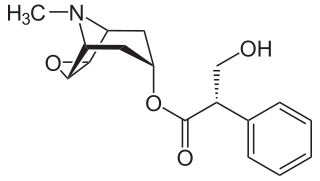
Histamine is an organic nitrogenous compound involved in local immune responses communication, as well as regulating physiological functions in the gut and acting as a neurotransmitter for the brain, spinal cord, and uterus. Discovered in 1910, histamine has been considered a local hormone (autocoid) because it's produced without involvement of the classic endocrine glands; however, in recent years, histamine has been recognized as a central neurotransmitter. Histamine is involved in the inflammatory response and has a central role as a mediator of itching. As part of an immune response to foreign pathogens, histamine is produced by basophils and by mast cells found in nearby connective tissues. Histamine increases the permeability of the capillaries to white blood cells and some proteins, to allow them to engage pathogens in the infected tissues. It consists of an imidazole ring attached to an ethylamine chain; under physiological conditions, the amino group of the side-chain is protonated.

Histamine H3 receptors are expressed in the central nervous system and to a lesser extent the peripheral nervous system, where they act as autoreceptors in presynaptic histaminergic neurons and control histamine turnover by feedback inhibition of histamine synthesis and release. The H3 receptor has also been shown to presynaptically inhibit the release of a number of other neurotransmitters (i.e. it acts as an inhibitory heteroreceptor) including, but probably not limited to dopamine, GABA, acetylcholine, noradrenaline, histamine and serotonin.

The histamine H4 receptor, like the other three histamine receptors, is a member of the G protein-coupled receptor superfamily that in humans is encoded by the HRH4 gene.

Trazodone, sold under many brand names, is an antidepressant medication, used to treat major depressive disorder, anxiety disorders, and insomnia. It is a phenylpiperazine compound of the serotonin antagonist and reuptake inhibitor (SARI) class. The medication is taken orally.

Dopaminergic means "related to dopamine", a common neurotransmitter. Dopaminergic substances or actions increase dopamine-related activity in the brain.

The H1 receptor is a histamine receptor belonging to the family of rhodopsin-like G-protein-coupled receptors. This receptor is activated by the biogenic amine histamine. It is expressed in smooth muscles, on vascular endothelial cells, in the heart, and in the central nervous system. The H1 receptor is linked to an intracellular G-protein (Gq) that activates phospholipase C and the inositol triphosphate (IP3) signalling pathway. Antihistamines, which act on this receptor, are used as anti-allergy drugs. The crystal structure of the receptor has been determined (shown on the right/below) and used to discover new histamine H1 receptor ligands in structure-based virtual screening studies.

ABT-239 is an H3-receptor inverse agonist developed by Abbott. It has stimulant and nootropic effects, and has been investigated as a treatment for ADHD, Alzheimer's disease, and schizophrenia. ABT-239 is more active at the human H3 receptor than comparable agents such as thioperamide, ciproxifan, and cipralisant. It was ultimately dropped from human trials after showing the dangerous cardiac side effect of QT prolongation, but is still widely used in animal research into H3 antagonists / inverse agonists.

A muscarinic receptor antagonist (MRA), also called an antimuscarinic, is a type of anticholinergic agent that blocks the activity of the muscarinic acetylcholine receptors (mAChRs). The muscarinic receptors are proteins involved in the transmission of signals through certain parts of the nervous system, and muscarinic receptor antagonists work to prevent this transmission from occurring. Notably, muscarinic antagonists reduce the activation of the parasympathetic nervous system. The normal function of the parasympathetic system is often summarised as "rest-and-digest", and includes slowing of the heart, an increased rate of digestion, narrowing of the airways, promotion of urination, and sexual arousal. Muscarinic antagonists counter this parasympathetic "rest-and-digest" response, and also work elsewhere in both the central and peripheral nervous systems.

Antihistamines are drugs which treat allergic rhinitis, common cold, influenza, and other allergies. Typically, people take antihistamines as an inexpensive, generic drug that can be bought without a prescription and provides relief from nasal congestion, sneezing, or hives caused by pollen, dust mites, or animal allergy with few side effects. Antihistamines are usually for short-term treatment. Chronic allergies increase the risk of health problems which antihistamines might not treat, including asthma, sinusitis, and lower respiratory tract infection. Consultation of a medical professional is recommended for those who intend to take antihistamines for longer-term use.
A histamine agonist is a drug which causes increased activity at one or more of the four histamine receptor subtypes.

Eglumetad is a research drug developed by Eli Lilly and Company, which is being investigated for its potential in the treatment of anxiety and drug addiction. It is a glutamate derived compound and its mode of action implies a novel mechanism.
An H3 receptor antagonist is a type of antihistaminic drug used to block the action of histamine at H3 receptors.

A-349,821 is a potent and selective histamine H3 receptor antagonist (or possibly an inverse agonist). It has nootropic effects in animal studies, although there do not appear to be any plans for clinical development at present and it is currently only used in laboratory research.
GSK-189,254 is a potent and selective H3 histamine receptor inverse agonist developed by GlaxoSmithKline. It has subnanomolar affinity for the H3 receptor (Ki = 0.2nM) and selectivity of over 10,000x for H3 over other histamine receptor subtypes. Animal studies have shown it to possess not only stimulant and nootropic effects, but also analgesic action suggesting a role for H3 receptors in pain processing in the spinal cord. GSK-189,254 and several other related drugs are currently being investigated as a treatment for Alzheimer's disease and other forms of dementia, as well as possible use in the treatment of conditions such as narcolepsy, or neuropathic pain which do not respond well to conventional analgesic drugs.

Proxyfan is a histamine H3 receptor ligand which is a "protean agonist", producing different effects ranging from full agonist, to antagonist, to inverse agonist in different tissues, depending on the level of constitutive activity of the histamine H3 receptor. This gives it a complex activity profile in vivo which has proven useful for scientific research.

JNJ-5207852 is a histamine antagonist selective for the H3 subtype. It has stimulant and nootropic effects in animal studies, and has been suggested as a possible treatment for some memory defects associated with epilepsy. JNJ-5207852 itself did not progress to clinical development due to poor pharmacokinetic characteristics, but the related compound JNJ-17216498 was in a Phase II clinical trial for the treatment of narcolepsy in 2007.
Pitolisant, sold under the brand name Wakix among others, is a medication used for the treatment of excessive daytime sleepiness in adults with narcolepsy. It is an inverse agonist of the histamine 3 (H3) receptor (an antihistamine drug specific to that kind of receptors). It represents the first commercially available medication in its class, so that the U.S. Food and Drug Administration (FDA) declares it a first-in-class medication. Pitolisant enhances the activity of histaminergic neurons in the brain that function to improve a person's wakefulness. It was approved by the European Medicines Agency (EMA) in March 2016 for narcolepsy with or without cataplexy, and for excessive daytime sleepiness by the FDA in August 2019. The most common side effects include difficulty sleeping, nausea, and feeling worried.

A wakefulness-promoting agent (WPA), or wake-promoting agent, is a drug that increases wakefulness and arousal. They are similar to but distinct from psychostimulants, which not only promote wakefulness but also produce other more overt central nervous system effects, such as improved mood, energy, and motivation. Wakefulness-promoting agents are used to treat narcolepsy and hypersomnia as well as to promote wakefulness and increase performance in healthy people.

FG-8205 (L-663,581) is an imidazobenzodiazepine derivative related to bretazenil, which acts as a partial agonist at GABAA receptors, with slight selectivity for the α1-containing subtype. In animal tests it has anxiolytic and anticonvulsant effects but with little sedation or ataxia produced.
Samelisant (INNTooltip International Nonproprietary Name; developmental code name SUVN-G3031) is an experimental wakefulness-promoting agent acting as a selective histamine H3 receptor inverse agonist which is under development for the treatment of narcolepsy. It was also under development for the treatment of cognition disorders and Parkinson's disease, but no recent development has been reported for these indications. As of June 2024, samelisant is in phase 2 clinical trials for the treatment of narcolepsy.














